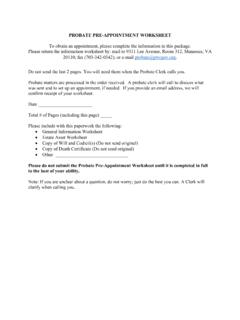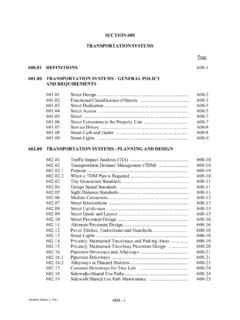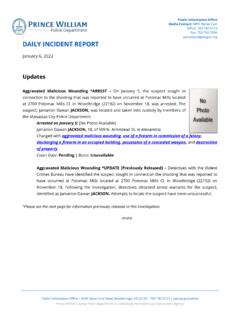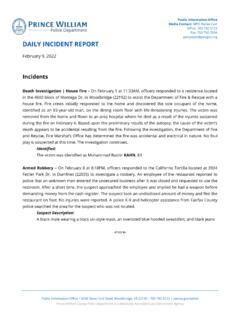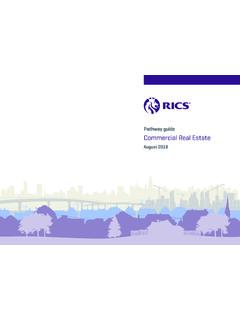Transcription of Page intentionally left blank
1 First Draft: January 31, 2022. Page intentionally left blank TABLE OF CONTENTS. III. INTENT ..1. VISION AND QUALITY OF LIVE VALUES ..2. LAND USE & DEVELOPMENT LAND USE PRINCIPLES .. 5. GUIDING LAND USE PATTERNS ..5. LAND USE INTENSITY ..6. HARMONIOUS LAND USE PATTERNS (COMPATIABILITY) ..7. DESIGN GUIDELINES (QUALITY OF DEVELOPMENT & PLACEMAKING) ..8. COORDINATION OF DEVELOPMENT (TIMING) ..9. ALIGNMENT WITH MOBILITY AND HOUSING CHAPTERS ..11. CULTURAL RESOURCES ..12. ECONOMIC DRIVERS ..14. EQUITY ..15. PLACE TYPES (DEVELOPMENT PATTERNS AND CONCEPTS)..18. Multimodal Districts ..22. Multimodal Centers (Activity Centers)..23. Multimodal Corridors ..23. Adaptive Reuse ..25. infill Development ..25. Complete Neighborhoods ..26. Special Planning Areas ..27. MCBQ Joint Land Use Study ..27. Manassas REGIONAL Airport ..28. Small Area Plans ..28. Sector Plans ..29. LAND USE FRAMEWORK .. 30. LONG-RANGE LAND USE CLASSIFICATIONS AND MAP ..33. The Urban Communities ..34. URBAN DESIGN POLICIES ..39.
2 Suburban Communities ..41. SUBURBAN DESIGN POLICIES ..49. i TABLE OF CONTENTS. TRANSITION NEIGHBORHOODS ..51. TRANSITION NEIGHBORHOOD DESIGN POLICIES ..53. RURAl Communities ..53. RURAL Village ..59. Hamlet ..59. Residential Cluster ..59. COUNTYWIDE CLASSIFICATIONS ..63. Overlay Districts ..67. LAND USE COMPATIBILITY .. 71. LAND USE COMPATIBILITY LAND USE DESIGNATION AND ZONING DISTRICT COMPATIBILITY MATRICES ..73. APPENDICES .. 75. PUBLIC FACILITY REVIEWS PROCESS ..75. COMPREHENSIVE PLAN AMENDMENT LAND USE GLOSSARY ..79. LONG-RANGE LAND USE ii TABLE OF CONTENTS. FIGURE 1: QUALITY OF LIFE VALUES ..2. FIGURE 2: RURAL TO URBAN SPECTRUM ..19. FIGURE 3: TABLE OF FORM ELEMENTS ASSOCIATED WITH TRANSECTS ..19. FIGURE 4: SIX MULTIMODAL CENTER TYPES ..20. FIGURE 5: MULTIMODAL SYSTEM PLAN ..21. FIGURE 6: DISTRICTS, CENTERS, REDEVELOPMENT CORRIDORS IN PRINCE WILLIAM COUNTY ..22. FIGURE 7: GENERAL CHARACTER AREAS ..31. FIGURE 8: LAND USE COMPATIBILITY MATRIX ..72. FIGURE 9: COMPATIBILITY MATRIX - ZONING AND COMPREHENSIVE PLAN DESIGNATIONS RESIDENTIAL.
3 73. FIGURE 10: COMPATIBILITY MATRIX - ZONING AND COMPREHENSIVE PLAN DESIGNATIONS - NON-RESIDENTIAL ..74. iii Page intentionally left blank LAND USE CHAPTER. INTRODUCTION. INTENT. The Land Use Chapter provides a development vision as to how the county will utilize its land resources. In addition, this Chapter provides a plan to accommodate future development in an efficient and sustainable way that is compatible with the character of various communities while protecting the valuable and sensitive natural resources throughout the County. The Land Use Chapter provides integration of environmental justice, equitable development, and smart growth approaches to establish healthy, inclusive and sustainable neighborhoods through the development of a Land Use Plan. The Land Use Plan considers the County's existing and future needs for commerce, environmental protection, energy efficiency, historic preservation, housing, industry, public and semi-public facilities, parks and recreation, transportation, as well as social and economic sustainability.
4 Prince William County, as a locality within the Washington metropolitan region, recognizes that growth and change will occur, and embraces the belief that change is vital to the well-being of the community. Over the past two decades, Prince William County has experienced significant growth pressures and while population continues to grow, the supply of land capable of supporting development continues to decrease. To address this situation and accommodate growth, the land use plan incorporates best planning practices that encourage the provision of diverse housing choices, mixed land uses, while protecting the established character of existing urban, suburban, and rural neighborhoods. Prince William County's strategy for accommodating future growth and creating equitable and sustainable communities builds on the foundation of its many diverse neighborhoods and aims to create a better community by providing: a variety of housing options, locations for employment growth, walkable communities with good transit access, services and the infrastructure needed to support growth, respect for the natural environment and enhancements to the County's cultural resources, and growth that enables all residents to participate in the County's economy and civic life.
5 This Plan envisions a County where growth builds stronger neighborhoods, heightens our stewardship of the environment, leads to enhanced economic opportunity and security for all residents, and is accompanied by greater race and social equity across Prince William County's communities. The Land Use Plan encompasses the gamut of Countywide land uses from desirable and well-designed neighborhoods, to high-density and intensity mixed-use centers at strategic locations, to quiet and serene rural communities. To further enhance and improve the quality of life in Prince William County, this chapter presents countywide policies that will allow the County to address growth and development in future planning and implementation initiatives that achieve smart growth principles while acknowledging the unique characteristics of the County that residents value. 1. LAND USE CHAPTER. VISION AND QUALITY OF LIVE VALUES. This Chapter is an official statement of the County's vision for land use and development pattern.
6 The Land Use Plan continues to consciously manage the timing, location and characteristics of growth. It expresses the community's aspirations and goals for the County's future, while articulating a corresponding set of policies and recommendations called action strategies to guide future decisions regarding land use, development and capital improvements. The Plan's vision is built upon the land use concepts of incorporating equity and sustainability while embracing the Quality of Life Values that are important to the community. Developing processes that further the land use vision will ensure success in implementing the plan. Providing the tools necessary to achieve the vision establishes a pathway to success. Review of public facilities to ensure investment in public infrastructure furthers the vision is a critical component of plan implementation. Vision Prince William County is a diverse and thriving community that strives to be an equitable, sustainable, and vibrant place which offers access to a variety of employment, housing and mobility opportunities while respecting our distinct cultural and environmental resources as well as promoting the quality-of-life values that establish a unique sense of place.
7 Quality of Life Values Quality of Life Values refers to the overall quality of one's daily experiences that are defined in terms of happiness and contentment, health, and well-being. There are seven conditions from a Planning perspective that are needed to create a successful and sustainable community. Figure 1: Quality of Life Values 2. LAND USE CHAPTER. Accessible Community: Connect community amenities, facilities, and services through equitable access to adequate infrastructure using multi-modal or digital technology options to the reach these important resources including opportunities for life-long learning, leisure and recreational activities, employment as well as other elements that create a healthy, safe, and secure community. Community Collaboration: Encourage civic involvement in policy change and development process while ensuring transparency and accountability through open communications by engaging all residents and stakeholders, including our vulnerable and underserved populations.
8 Cultural & Environmental Stewardship: Cultivate an appreciation of ownership in the process of preserving and enhancing all the County's history (districts, buildings, sites, cemeteries, and landscapes) as well as environmental resources through the preservation of open space, the incorporation of design features, best practices, policies and strategies that promote long term efficiency and sustainability of these valuable assets. Economic Prosperity: Promote economic opportunities that promote a mix of businesses that maintain and create jobs that offer living wages, expand the commercial tax base, and enhance the quality of life for all residents while promoting entrepreneurship and innovation, and workforce development. Inclusive Community: Embrace the vibrant culturally and ethnically diverse population that makes our community distinct while creating conditions through an equity lens that allow all to participate and reach their full potential. Housing Opportunities: Ensure an adequate supply of affordable and diverse types of housing options that meet the needs of all County residents with consideration to neighborhood preservation and universal design for aging in place.
9 Healthy & Supportive Community: Foster access to enhanced environmental, recreational and cultural opportunities, ensuring these benefits and these amenities are available to all residents as part of a healthy and supportive community. LAND USE & DEVELOPMENT TRENDS. Prince William County is part of the Washington metropolitan area and is geographically located approximately 23 miles south of Washington and 70 miles north of Richmond, Virginia. The County encompasses approximately 207,621 acres, or square miles. The County's is encompassed by natural boundaries include the Potomac River to the east, the Occoquan River/Reservoir & Occoquan Bay to the northeast and the Bull Run River to the northwest, and Chopawamsic Creek to the southeast. Prince William County is also bound by other political subdivisions of the Commonwealth of Virginia including Fairfax County to the north and northeast, Loudoun County to the north and northwest, Fauquier County in the west and southwest, Stafford County in the south and the City of Manassas Park in the north and City of Manassas in central part of the County.
10 On the eastern side of Prince William County and across Potomac River is Charles County, Maryland. The predominant pattern of development in the County consists of a mix of urban character development mostly in the east, suburban character in the east, central and western areas along major corridors and roads, rural character in the northwestern and southwestern portions of the 3. LAND USE CHAPTER. County. This diversity offers a choice in use and lifestyle from the urbanized communities, inland suburban communities to the rural communities. Dispersed throughout the County are several distinct Residential Planned Communities (RPC) that vary in land use and density. In general, these RPC communities include a core of local-serving commercial uses, services, schools, and public facilities surrounded by residential neighborhoods. 4. LAND USE CHAPTER. LAND USE PRINCIPLES. GUIDING LAND USE PATTERNS. Long-Range planning involves the purposeful arrangement of land use in a balanced, equitable and orderly manner.
